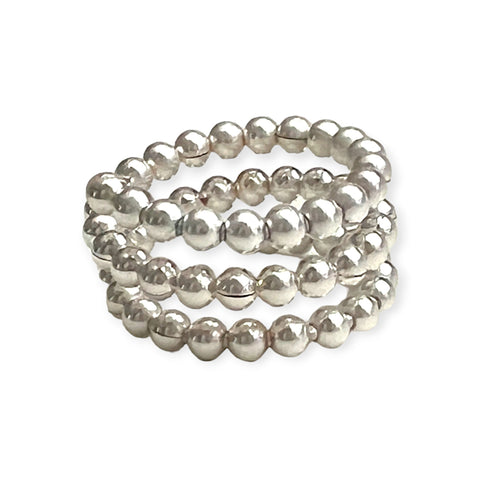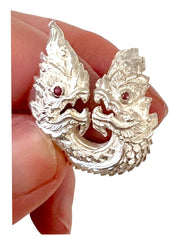
Silver Jewelry - Is Sterling Silver Real?
5 min reading time

5 min reading time
Silver is a special metal that is one of the original recognized since antiquity. Its often associated with wealth and beyond that modernity, glamour, grace, and elegance. We wanted to share some details with you to better appreciate and care for your silver jewelry, specifically your sterling silver pieces.
Is sterling silver jewelry real silver jewelry?
The short answer is yes, and that’s what you want. In a nutshell, sterling silver is silver with a bit of copper added to make an allow. That is because despite all of silver’s wonderful attributes; its high polish, lovely color – it is missing is hardness. On its own it is very soft, ductile, and malleable features that do not make for good, lasting jewelry.
To ensure that the silver jewelry maintains its shape and has sufficient strength to withstand wear and tear, copper is added to make an allow (a metal combined of two or more metallic elements designed to achieve greater strength or resistance to corrosion). The copper makes the silver harder, more durable, and therefore better to work with and use, but without compromising on color. Consequently, most silver jewelry that is available is sterling silver.

What is silver?
Silver is one of the seven metals of antiquity known to our prehistoric ancestors, the others being gold, copper, tin, lead, iron and mercury.
It is a more reactive metal than gold and harder to extract from its ores when mined. This meant that in ancient times silver supplies were rarer and therefore more expensive than gold.
This changed around 1500 BC when the Egyptians discovered new methods of refining it that made it easier. Today silver is less valuable than gold, which is rarer in nature and more difficult to mine in bulk to meet the demand.

Silver exhibits the highest electrical conductivity, thermal conductivity, and reflectivity of any metal. Some solutions of silver serve as disinfectants and microbicides
Where is it from?
Thailand is blessed with silver deposits, indeed, much of the silver from northern part of the country where the mines are located and silver jewelry is an established craft of the Hill Tribe people. Most of the designers we work with at Sundara Joon are, no surprise from Thailand and from the northern region.
What is sterling silver?
Sterling silver is an alloyed form of silver (silver + copper) which renders it suitable to use in jewelry and other metalwork.

Fine silver is 99.9% pure silver. In this form the metal is beautiful and rarely tarnishes, but it is generally too soft and malleable for most uses such as jewelry. Sterling silver is fine silver alloyed with copper and is 92.5% pure silver and 7.5% copper. This percentage of fine silver is why you will sometimes see sterling silver referred to as '925 silver' or hallmarked with a "925" stamp. We saw this information presented this way in SE Asia for example.
If you see "999", that indicates fine silver at 99.9% pure. No legal requirement exists to add either stamp, so pieces you have may well be sterling silver but just not marked as such. Reasons for this omission may include some artists feel that the stamp diminishes from the design, or the stamp simply doesn’t fit on the jewelry or item.
Cleaning silver
Can silver jewelry turn black? The answer is “yes”, and it is to be expected, but it is also easy to resolve. The copper reacts (oxidizes) with the sulfur or other environmental elements and cause the silver to tarnish and discolor. This process is accelerated in humid conditions.
Be especially gentle with silver when cleaning it (link to Martha Stewart website for ideas). Never use harsh cleansers as they remove some of the metal over time, and here is another cleaning idea source (Architecture Digest).
Ways to determine if you have real silver
With a strong magnet (e.g., a rare-earth neodymium magnet) determine if the magnet attaches to the metal. If it does, you either do not have silver or the piece may be silver plated over a base metal. Bear in mind that there are other metals that are not magnetic, so this is not a conclusive test.
Not for the faint of heart, dab a tiny amount of chlorine bleach on the jewelry in an inconspicuous spot and watch for a reaction. Silver (including silver plating) generally turns brown or black in the presence of bleach. Once you have completed the test, rinse the metal well afterwards and use a polishing cloth or silver dip to try to remove the discoloration (no guarantees it will come off, so choose the test spot wisely).
Don’t wear silver when –
Something says it is nickel silver which is an alloy that contains NO silver just copper 60%), nickel (20%) and zinc (20%). It is cheap, and durable, but not silver. Its name is because of its appearance but looks can be deceiving. Despite the Germanic name, it originated in China – more on the history here where it found a variety of uses from musical instruments to coins. Exposure to acidic substances (including milk with its lactic acid can leach the copper and a cause skin rash)
That chlorine bleach test should give you a clue as to why you should never wear sterling silver jewelry in a swimming pool. Chlorine + silver = HARD NO

Now that we’ve given you a few ideas to consider, we have many options at Sundara Joon. We also offer some silver-plated alternatives which we clearly distinguish form the pure sterling silver pieces. Check out our silver pieces here.